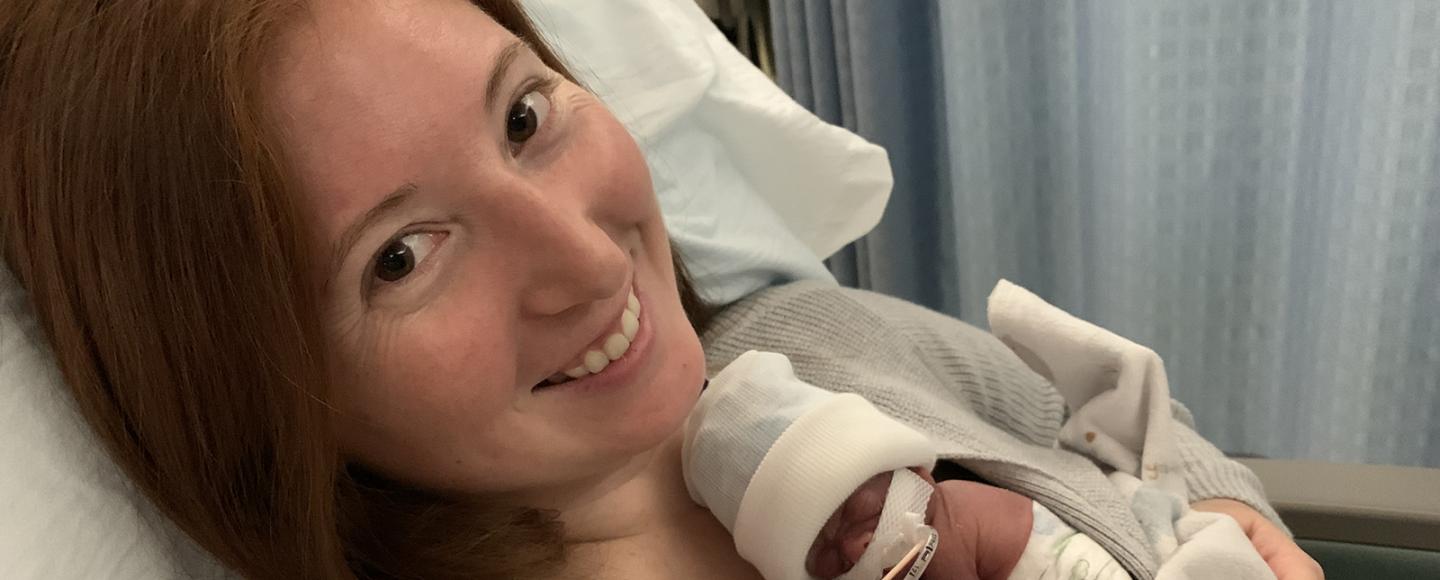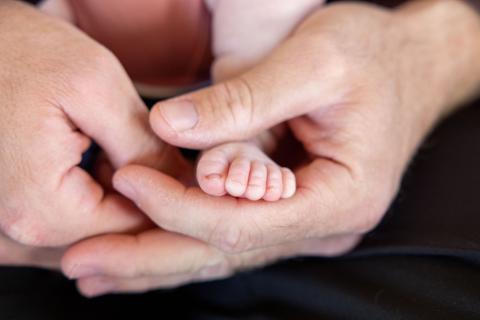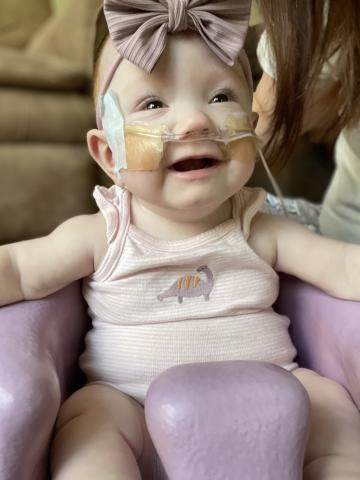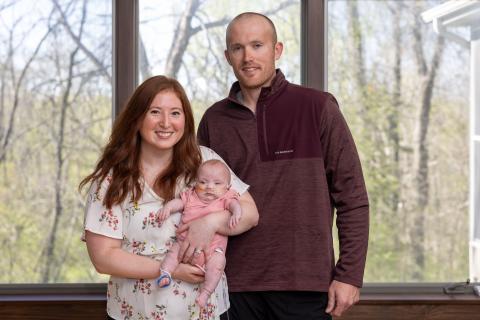Table of ContentsClose

Eight-and-a-half ounces.
That’s roughly the weight of two sticks of butter, a roll of quarters, or a smartphone.
It’s also how much Evelyn Eilers weighed when she was born 17 weeks early at University of Iowa Health Care in September 2023, making her the smallest surviving infant in the U.S., and one of three tied for third-smallest in the world, according to the Tiniest Babies Registry.
Evelyn weighed 240 grams, or 8.46 ounces, at birth. When she went home at 7 months old, she weighed 7 pounds 8 ounces—the size of an average full-term newborn.
Evelyn’s parents, Emily and Ted Eilers of Solon, Iowa, knew their daughter had the best team working for her. The survival outcomes for extremely premature infants at UI Health Care Stead Family Children’s Hospital are among the best in the world. And when Evelyn was diagnosed with an often-fatal condition, a treatment protocol designed by UI doctors and researchers saved her life.
“Even when she was sick, the doctors and nurses had already done so much to get her to that point, I was confident they would get her through it,” Ted Eilers says. “And they did. I don’t think she would have made it if she was anywhere else.”
UI Health Care Stead Family Children’s Hospital is home to Iowa’s only Level 4 Neonatal Intensive Care Unit, the highest level recognized by the American Academy of Pediatrics. The NICU at Iowa is unique in that it includes specialty teams—in neonatal hemodynamics, lung rehabilitation, and neurocritical care—that provide consultative support to care for premature and extremely high-risk infants.

A concerning pregnancy—and an emergency birth
The first few months of Emily Eilers’ pregnancy went fine, but during an ultrasound after her 16-week checkup, doctors discovered that Evelyn was having trouble growing. At the time of the ultrasound, she was in the first percentile for growth. Doctors cautioned the Eilers that their baby might not make it to 24 weeks, and if she did, there would be weekly ultrasounds from that point on.
At 23 weeks, Emily started noticing a decline in Evelyn’s movements. She dismissed it at first as perhaps not paying as close attention, but when the movements didn’t increase, she began to worry.
The Saturday after Labor Day—Sept. 9, 2023—the Eilers were in Iowa City running errands, and Emily decided to call the hospital, even though she had an appointment in two days.
“I remember being told that if I called in with any concerns, I was to tell them I’d been given a severe growth restriction diagnosis,” Emily recalls.
She relayed the information to the nurse on the phone, and “they said if it hadn’t been for that they would have probably told me to wait for my appointment, but instead they told me to come in to make sure everything is OK,” Emily says.
By the time the Eilers arrived at UI Health Care, Evelyn’s movements had picked up, so everything seemed fine.
“But then, once things started happening, they really started happening,” Emily says.
Teams of doctors and nurses came in and out of Emily’s room talking about different parts of the process. Among them were neonatologist Timothy “TJ” Boly, DO (20R, 23F), and neonatology fellow Ashley Schlapper-Sevcik, DO, who talked to Emily and Ted about what to expect with an early birth.
“We talked about a lot of scary things: the risk of death, the risk of complications that come with prematurity and not being fully developed,” Boly says. “And the scariest part of the conversation is about measurements. When we talk about measurements when the baby is still inside, those are imperfect. Sometimes babies come out and they don’t weigh as much as what we were expecting, and my ability as a neonatologist is limited by the size of equipment I have.
“So, even though we try our hardest for every baby, sometimes babies are just too small, and the breathing tube I want to use just isn’t small enough,” Boly adds.
Within a few hours, Evelyn’s heart rate had dropped, and the care team called for an emergency cesarean section. By 3 p.m. that day, Evelyn was born and taken to the neonatal intensive care unit (NICU) at the children’s hospital.
Life-saving treatment developed at Iowa
Despite Evelyn's tiny size, she was able to clear her first major hurdle: Her head and mouth were able to accommodate the breathing tube.
“She was definitely one of the smallest babies I’ve ever seen,” Boly recalls. “I told her family right away that the best thing about her being small was that her head was bigger than the rest of her and her mouth was a normal and nice, big size, so I was able to get the breathing tube in very quickly.”
The breathing tube helped Evelyn’s still-developing lungs function properly, but her lungs and the rest of her organs still needed to continue to develop outside the womb as they would if she were still inside.
“There are a lot of things that go into [caring for] really small babies, but it’s essentially managing every body system every single day—not even just on a day-to-day basis, but sometimes an hour-to-hour basis,” Boly says.
There were other obstacles to clear. During her first week, one of Evelyn’s lungs was deflating a bit more than the other, causing the open lung to endure more pressure from the ventilator. Evelyn also was urinating more than normal, causing her to become dehydrated.
But the biggest hurdles came when Evelyn was about a month old. She developed two new conditions, both of which carry high death rates. First, Evelyn developed necrotizing enterocolitis (NEC), a life-threatening infection in her intestine. In addition, the NEC led her to develop capillary leak syndrome, a rare but historically fatal condition that caused some of her smallest blood vessels to break apart and leak fluid into surrounding tissues.
Pediatric surgeons removed the damaged part of her intestine, and immediately following surgery, Boly implemented a new treatment protocol for the capillary leak syndrome that he had developed with other physician-scientists at Iowa. The treatment involves three medications: a high-dose steroid to reduce inflammation, an asthma medication that has been found to heal the capillaries, and intravenous immunoglobulin to help the immune system clear infection.
The UI Health Care team started using the protocol in infants in 2021. Boly says that in the five years prior, the mortality rate for capillary leak syndrome was 100%. With the new treatment, he says, it's 20%.
Soon after surgery and the treatment for capillary leak syndrome, Evelyn began to thrive.
“It was amazing to see her just become a baby who liked to interact in real life and loved having people around—she was a smiley, happy girl almost immediately,” Boly says. “She was able to tolerate getting more and more milk into her belly and to grow. And then she just flourished and developed.”

Happy to be home
More than seven months after her birth, Evelyn was able to go home. She’s still on constant oxygen and receiving nutrition through a feeding tube, but she is otherwise a typical newborn. She smiles at the sound of her parents’ voices, she lets them know when she’s not happy or comfortable, and she draws curious sniffs from the family’s dogs.
“Home life was an adjustment at first,” Emily recalls. “We took for granted just how much the nurses and the care team were doing for us. But now we’re in the swing of it all and we have a routine down. [Evelyn’s] fitting right in, she loves being home.”
The Eilers remain grateful to have had the NICU team so close.
“We didn’t know anything about small babies, but we got extra lucky to have been where we were,” Ted says. “From the beginning, we knew we were in the best hands. They gave us an idea of how things might go well or how they might not, and they were there for all of it.”
As for the title of tiniest surviving baby in the United States?
“That doesn’t mean a lot to us,” Emily says. “To us, she’s just Evelyn.”


Worldwide 'Tiniest Babies Registry' created at Iowa
On New Year’s Day in 1994, Ed Bell, MD, helped deliver a baby girl born at 27 weeks’ gestation. She weighed 359 grams, or about 12.6 ounces.
“The baby’s parents asked me if I knew of other infants born that small who had survived,” says Bell, a neonatologist at University of Iowa Health Care Stead Family Children’s Hospital. “That made me curious, so I started a search.”
With the internet not yet available, Bell pored through medical journals and news accounts, “gathering up information on these extremely rare children,” he says.
Over time, Bell accumulated enough information to launch the Tiniest Babies Registry in 2000, a listing of the world’s smallest surviving babies, all of whom were born weighing less than 400 grams, or 14.1 ounces.
There are over 300 babies on the list, with the earliest a baby girl born in Chicago in 1936. Users can sort according to year of birth, birth weight, state of birth, and more.
When Evelyn Eilers was discharged from Stead Family Children's Hospital in April 2024 at 7 months old, her name was added to the list. She was born at 23 weeks’ gestation weighing 240 grams, or 8.46 ounces.
But the registry isn’t meant to encourage competition to see who can save the smallest babies.
“It’s to try to collect what’s out there so doctors and parents know there have been survivors that small and get what information we can about how they’re doing,” Bell says. “It exists just so parents and doctors know these babies are out there and it is possible. It’s so we don’t automatically say, ‘There’s no hope.’”
“No hope” is not a message UI Health Care neonatologists send out. Working with parents and obstetricians at UI Health Care and other referring hospitals, the team’s philosophy is that “prematurity is not a cause of death.”
It’s one of the reasons outcomes for extremely premature infants at UI Health Care are better than the national average, Bell says. And the registry speaks to that: Of the babies included on the registry, 28 were born in Iowa and 22 of those at UI Health Care.
